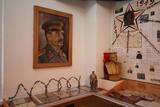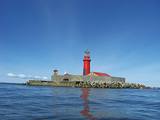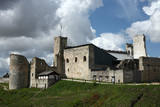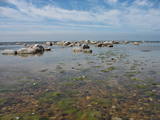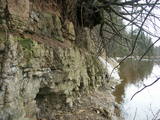| Nr | Nosaukums | Apraksts |
|---|---|---|
|
Jaukta plāna Ilzenberga muižas parks, izveidots 19.gs. otrajā pusē, ir palicis tāds pats līdz mūsdienām. Gleznaina, izteiksmīga reljefa vietā starp Ilgio un Apvalasa ezeriem. Atjaunojot parku, saglabāta bijušā parka telpiskā struktūra. Parks aizņem 10 ha teritoriju un ir veidots no divām daļām. Pirmā – tā ir salīdzinoši prezīca tainsstūra formas teritorija blakus muižai, apjozta ar mazlapu liepu rindām un ainaviski izvietotiem vietējo un introducēto koku sugu stādījumiem. Otrā daļā – dabiskā meža tipa stādījumi. Lielākais Ilzenberga muižas parkā augošais ozols ir pasludināts par valsts apskargājamo dabas mantojuma objektu. Šī varenā koka stumbra apkārtmērs – 6.3 m, diametrs – 2 m, augstums – 30,5 m. |
||
|
Kurzemes cietokšņa muzejā skatāma bagātīga un saistoša ekspozīcija par Otrā pasaules karadarbību Kurzemes cietoksnī un tālākajiem latviešu karavīru likteņiem. Te apskatāma I un II Pasaules kara vēstures ekspozīcija ar novadpētnieciska un militāra rakstura priekšmetu kolekciju, YI-2 lidmašīna, bruņutransportieris, Sarkanās armijas tanks (viena no retajām vietām Latvijā, kur šāds objekts ir saglabājies) un izstaigājami restaurētie tā laika ierakumi un bunkuri. Kolekcijas veidotājs ir nozares entuziasts un vietējais novadpētnieks.
|
||
|
Interesantās formas no laukakmeņiem veidotā kapela celta 19. gs. Apskatāma no ārpuses. |
||
|
Ģimenes uzņēmumā “Burka un ledus” audzē un pārstrādā asos piparus. Apmeklētājiem piedāvā degustācijas un ekskursiju pa ražotni. |
||
|
Biedrība ikvienam interesentam piedāvā praktiskas nodarbības ar taustāmiem rezultātiem - darbošanos ar savām rokām īstā darbnīcas vidē - koka amatniecība, rokdarbi, sveču liešana. Darbošanās patstāvīgi ar iespējamu palīdzību visos līmeņos, ko sniedz pieredzējuši meistari. Iepriekšējas iemaņas nav nepieciešamas. |
||
|
Uz mākslīgi veidotas salas jūrā (salu uzbēra
1872. – 1875. g) sākotnēji uzcēla koka bāku, kurā gaismu iededzināja
1875. g. jūnijā. Kad sala nosēdās, uz tās uzcēla tagadējo bākas torni, kas
sāka darboties 1884. g. 1. jūlijā. Bāka mūsdienās atrodas 6 km (celšanas
brīdī – 5 km) attālumā no Kolkasraga, tā zemūdens smilšainā sēkļa galā.
Uz salas vēl atrodas bākas uzrauga ēka un vairākas saimniecības ēkas.
21 m augstais bākas metāla konstrukcijas tornis izgatavots
Sanktpēterburgā. Kopš 1979. g. bāka strādā automātiskā režīmā.
|
||
|
Apskates saimniecība “Bites” dibināta 1997. gadā. Saimnieki Ilga un Jurijs Ivanovi saimnieko pašā Latvijas pierobežā, Zilupes novadā. Atklātā laukā tiek audzētas melones, arbūzi un ķirbji, kā arī tiek sniegti lauku tūrisma pakalpojumi. Ilga vada floristikas meistarklases un rudzu salmu pārvērtību darbnīcu, kur rāda kā uz siena dakšām tiek veidotas šalles, somas, sīpolu uzglabāšanas maisiņi. Radošajās darbnīcās no rudzu salmiem iespējams radīt klasisko vai kāda īpašāka dizaina puzuru, rotājumu vai sedziņu. Ir iespējams iegādāties gatavu produkciju vai arī sagatavotus komplektus patstāvīgam darbošanās priekam. |
||
|
Picērija atrodas Kuldīgā netālu no pilsētas vēsturiskā centra. Stender’s picērijas jaukā, mājīgā vidē piedāvā īpašās Stender’s picas, kuras ir pagatavotas ievērojot senās picas cepēju tradīcijas apvienojot ar mūsdienu labākajām atziņām. Bez šaubām neiztikt bez pankūkām un podiņiem, kā arī otrajiem ēdieniem. |
||
|
Pils apmeklētāji varēs iegremdēties 16. gadsimta tematiskā parka gaisotnē un jauki pavadīt dienu kopā ar ģimeni, uz laiku iejusties bruņinieku un karavīru lomā. Piedāvājumā ir arī izjādes, šaušana ar loku un arbaletu, varēs izmēģināt roku kalēju un namdaru darbos, zelta un šaujampulvera taisīšanā, monētu kalšanā. Atvērts vīna pagrabs, moku kambaris, nāves istaba, viduslaiku bordelis, bārddziņa un alķīmiķa darba istaba, astronoma darba telpa. Turpat Šenkenberga krogā var nobaudīt pēc viduslaiku receptēm gatavotus ēdienus. |
||
|
„Vitrupe - Tūja” - nozīmīga teritorija rifu aizsardzībai. Teritorija atrodas iepretim Salacgrīvas novadam, tās platība ir 3577 ha. Teritorija ietver dabas lieguma „Vidzemes akmeņainā jūrmala” jūras daļu.
|
||
|
Virgas muiža kā lēnis tikusi piešķirta Livonijas ordeņa vasalim – Konrādam Noldem. Līdz mūsdienām saglabājusies Virgas muižas pils, kurā no 1935. gada līdz pat mūsdienām izvietojusies skola. Pilī atrodas baroneses trīs ar skaistiem kokgriezumiem rotātas durvis ar Noldes dzimtas ģērboni un baronu ģīmetnēm. Nedaudz nostāk no muižas centra (ciema ziemeļaustrumos) apskatāmas 19. gs. vidū celtās Holandes tipa vējdzirnavas, kas pēdējo reizi malušas 1939. gadā. Bijušā muižas klētī 1983. g. ierīkots Tradīciju nams, kas kalpo kā kultūras nams. Virgas muižu ieskauj parks, kurā uzmeklējama Barona Noldes un baroneses kapa vieta ar pieminekli. |
||
|
Atrodas Sēravotu ielā 10. Historisma stila celtne būvēta no koka 1899. gadā un ir jaunākā no trijām Ķemeru baznīcām. Baznīcu no iekšpuses var apskatīt dienās, kad notiek dievkalpojumi. Pārējā laikā – no ārpuses. |
||
|
Līdz 4 m augsts no ģeoloģiskā viedokļa - unikāls dabas objekts ar paleontoloģisku nozīmi, kurā konstatētas dažādu seno jūras bezmugurkaulnieku un fosilo zivju atliekas. Objekts nav labiekārtots, tādēļ visērtāk to ir apskatīt no Ogres pretējā - labā krasta.
|
||
|
Gauja ir Latvijas populārākā ūdenstūristu upe. Laivotājus šeit vilina skaistie smilšakmens atsegumi, upes mierīgais tecējums, dabas un lielā kultūras pieminekļu daudzveidība. Minētajā posmā upe plūst cauri Gaujas senlejai, kas ir viena no iespaidīgākajām Baltijas reljefa formām. Maršruta tehniski sarežģītākā vieta ir Ķūķu krāces, kur nereti gadās pa kādai apgāztai laivai. Lielākais upes kritums ir posmā no Amatas ietekas līdz Līgatnei, tādēļ daudzi braucēji izvēlas Cēsu – Līgatnes posmu. Maršruta informācija no Latvijas Lauku foruma |
||
|
Atrodas netālu no Biksēres muižas, blakus muižas parkam. Ozolkalna klēts saimniece Līga Kuba aušanas prasmes pirms pāris gadiem apguvusi Sarkaņu amatu skolā. Šeit radusies iecere par privātas aušanas darbnīcas izveidi, kas arī īstenota. Saimniece savas aušanas prasmes nodod jebkuram interesentam. Apmeklētāji var iegādāties šeit darinātos suvenīrus. |
||
|
Trušu audzēšanas saimniecība "Trušu muiža" savā allaž tapšanas procesā esošajā garaušu muižas kompleksā piedāvā aplūkot 15 – 20 dažādu šķirņu trušus no visas pasaules, kā arī iegūt bildi ar trusi. Lieliska iespēja ciemoties trušu "Harmonijas un miera sētā", tos samīļot, pabarot. "Trušu muiža" iegūst aizvien jaunus kaimiņus un pilnveidojas. Iespēja iegādāties "Trušu muižas" greznumlietas. Vaislas truši un mīļdzīvnieki. Vasaras sezonā (jūnijs - augusts) gaidīs ciemos no otrdienas līdz svētdienai (11:00 – 18:00). Lielākas grupas, iepriekš vienojoties, uzņem arī citā laikā. |
||
|
Celts Vilces pilskalna augšdaļā, no kuras paveras skats uz Rukūzes upītes ieleju, Zaķu pļavu un apkārtnes mežiem. Zemgales novadam neierasta ainava. Netālu atrodas Vilces muiža.
|
||
|
Piedāvā ļoti gardus Lietuviešu tradicionālos ēdienus. Var pieņemt līdz 80 personām. Pieņem bankas kartes, ir āra terase un dzīvā mūzika. Pieejama autostāvvieta. |
||
|
Ir saglabājies stāsts par kādu kuģa avārijā pie Kolkasraga izglābušos dāņu tirgotāju, kas kā pateicību Kolkā uzcēlis baznīcu. Kolkā ir bijušas vairākas baznīcas, kas mainījušas savu atrašanās vietu. Mūsdienās redzamā un no laukakmeņiem celtā Dievnama pamatus licis kādreizējais Dundagas muižas īpašnieks Karls Ludvigs Ferdinands fon der Osten – Zakens. Tā celta koka baznīcas vietā (vai tuvu tai), kas bija stipri cietusi Krimas kara laikā. Pirmos būvdarbus uzsāka būvmeistars Oto Zīverts 1885. gadā (arhitekts: T. Zeilers). Padomju laikā baznīca bija izdemolēta un tajā iekārtoja noliktavu. Aplūkot vērta ir modernā stilā veidotā altārglezna (māksliniece Helēna Heinrihsone), kurai neesot līdzinieces nevienā citā baznīcā. Pirms tam tās vietā atradies krusts. |
||
|
Sāmsalas ziemeļrietumu daļā jūrā iestiepjas iespaidīgā Tagameizas pussala (Tagamõisa poolsaar). Tās ziemeļrietumu daļā meklējama mazāka – ap 5 km garā Harilaidas pussala (Harilaid). Pussalas vidusdaļā viļņojas Lajalepas ezers (Laialepa järv) - bijušais jūras līcis, kas zemes garozai ceļoties, kļuvis par iekšēju ūdenstilpi. Arī pati Harilaida (igauniski „laid” nozīmē „saliņa”) vairāk nekā trīs gadsimtus atpakaļ bijusi sala. Harilaidu iecienījuši ne tikai migrējošie putni, bet arī roņi, kurus piesaista vientuļi līči un akmeņainās sēres. Harilaidu var apmeklēt tikai ar kājām vai ar divriteni, bet spēkrati ir jāatstāj autostāvlaukumā. No tā ~ 1 km attālumā atrodas vieta, kur pēc 17. gs. radies Harilaidas savienojums ar Sāmsalu. Šeit paveras nepierasti klaja un akmeņaina ainava. Pārējā Harilaidas daļa ir apmežota pirms ~ 40 gadiem. Kopumā būs jāveic ~ 10 km garš pārgājiens. |
||


